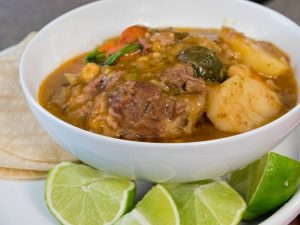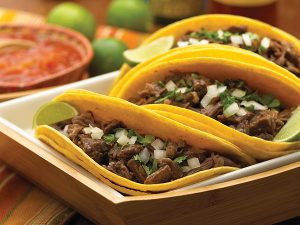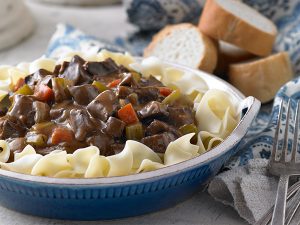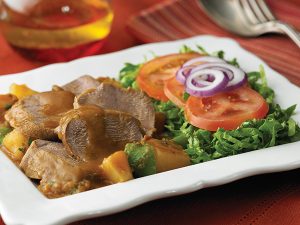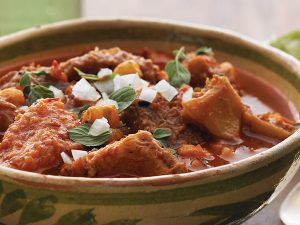White Menudo, a Perfect Winter Treat!
Featuring:
Rumba Meats® Beef Honeycomb Tripe
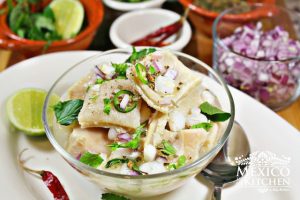
- 30 minutes Prep Time
- 2 hours, 30 minutes Cook Time
- 6 Servings

Original Blog & Recipe by
Mely Martinez
I’m Mely Martinez, passionate home cook and former teacher, born and raised in Mexico. Growing up, I was constantly thinking about food and watching how the women in my family cooked and prepared meals. Today, I enjoy teaching people how to cook Mexican food through my blog. Cooking my recipes with the best quality products is very important to me and Rumba Meats offers quality cuts of meat that are conveniently packaged and readily available.
White Menudo
One thing that I remember from my childhood was how my mother used to cook her Menudo; even though she had a pressure cooker that could cook those types of meats in a shorter amount of time, she preferred to cook it overnight in a large pot, leaving it to simmer gently for hours.
We lived in an apartment with a very small kitchen, and for hours the smell of garlic, beef, onion, and bay leaf filled all of the bedrooms. I’d wake up in the middle of the night to that delicious aroma, and in the darkness of the night, I would quietly sneak into the kitchen to find a spoon and taste the broth simmering in the huge pot. Almost always, I burned my mouth, but it didn’t matter as long as I could taste a little piece of the menudo. There’s something about its texture that makes it so interesting to eat. This soup takes me back to those moments in my mother’s kitchen in the
middle of the night.
Growing up in the north of Mexico, we always had menudo soup seasoned with a red sauce made of dried peppers. This soup however, called “White Menudo”, is similar to the one served in the States of Sinaloa and Nayarit, and even in some regions like in the States of Sonora, Jalisco and Baja California. Every state has its own way of serving this meal: you can find it with or without hominy, topped with chopped onion, mint, cilantro, Serrano peppers, or crushed dried peppers like árbol or piquín peppers. Some eat it with warm tortillas, while others prefer a piece of a French roll to dip into the soup.
ENJOY!
Directions
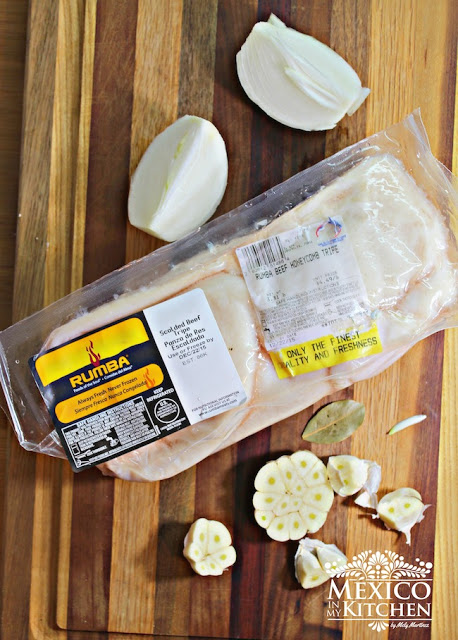
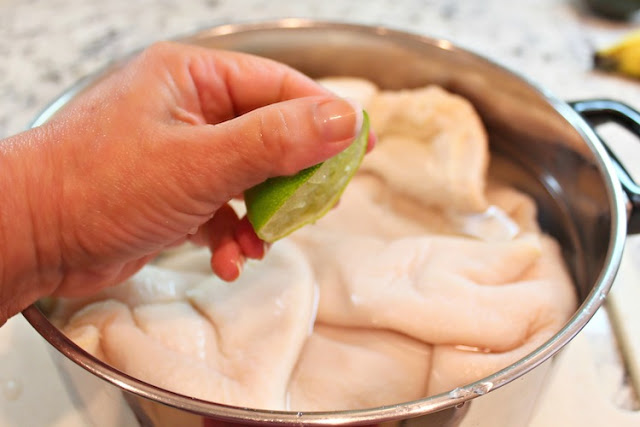
1.
Remove the Honeycomb tripe from the package,
drain and rinse. Place in a large pot or bowl and squeeze the lime juice over
the tripe and fill the pot with water. Let the tripe soak in that lime juice
and water solution for 30 minutes, then drain and rinse again. This step will
help eliminate any unpleasant smells from the tripe. Drain and rinse again, pat dry with paper towels,
and cut into 2-inch pieces. Place the pieces, with the onion, garlic and bay
leaf in a large pot with a lid and fill with the water.
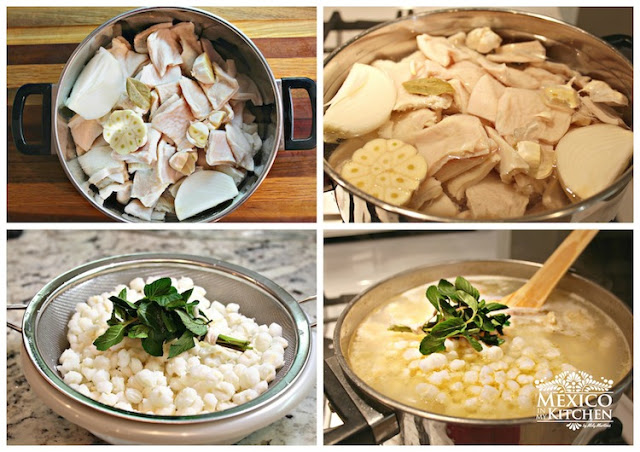
- Place on medium-high heat, and bring to a boil. Skim off the foam that will form on the top after a few minutes. Now, partially
cover the pot, reduce the heat to medium-low, and gently simmer for about 2
hours. If you are adding the calf’s foot, remove as soon as it has cooked. Once
it’s cool enough to handle, chop the meaty parts and discard the bones, return
the meat to the pot. - Add the drained and rinsed white hominy along with the sprig of mint. Keep cooking slowly, for about another ½ hour. If the tripe if too chewy, it needs more cooking. Well, cooked tripe should be tender when you bite it. Add salt
as needed. Some cooks like to add
granulated chicken bouillon to add more flavors to the broth instead of salt. - Serve the soup in bowls, and pass the garnishes around the table so everyone can add them to their personal liking.
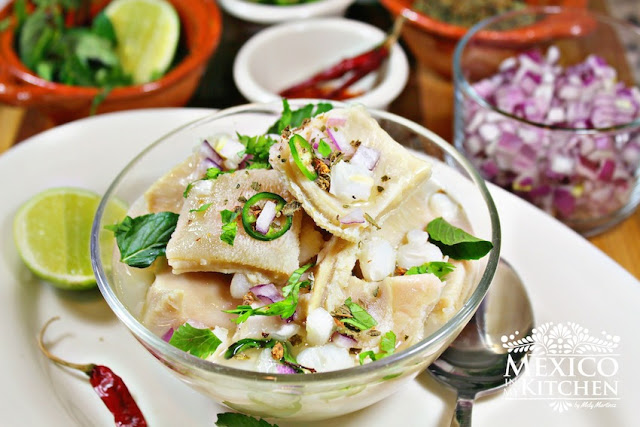
This soup reminds me a lot of the “Pho” soups served here in
the States at the Vietnamese restaurants. I hope you try it and come back to
let me know if you make any changes to the soup.
Provecho!
Mely
Ingredients
Ingredients
- Rumba Meats® Beef Honeycomb Tripe (3 pounds)
- 3 pounds of Honeycomb tripe
- 2 limes
- 1 head of garlic, cut in half
- 1 medium white onion cut in 4 pieces
- 1 bay leaf
- 6 quarts of water
- 2 (15 oz) cans of ready-cooked white hominy, rinsed and drained
- 3 small sprigs of mint
- Salt to taste
To Serve
- 1/2 red onion, finely chopped
- 1/2 cup of mint, finely chopped (or just the leaves)
- 1/2 cup cilantro, finely chopped
- 2 limes, cut in wedges
- 2-3 serrano peppers, finely sliced
- 3 teaspoons of dried Mexican oregano
- Piquin peppers, freshly crushed (optional)
- Warm corn tortillas or french bread
Recipe Notes
If you prefer to cook the hominy from scratch, use ½ pound dried hominy, rinse and soak overnight in a large pot filled with water. Drain the soaking water, then fill the pot with fresh water and cook at medium heat for about 1½ to 2 hours until the corn starts to pop open. You can also use Rumba® Scalded Beef Tripe for this soup.
Instructions
- Remove beef honeycomb tripe from package, drain and rinse. Place in a large pot or bowl, squeeze lime juice over tripe and fill the pot with water. Soak tripe in lime juice and water solution for 30 minutes, then drain and rinse again. This step will help eliminate any unpleasant smells from the tripe. Drain and rinse again. Pat dry with a paper towel and cut into 2-inch pieces. Place tripe pieces, onion, garlic and bay leaf in a large pot with a lid and fill with water.
- Place on medium-high heat and bring to a boil. Skim off the foam that will form on the top after a few minutes. Partially cover, reduce heat to medium-low and gently simmer for about 2 hours or until tripe is tender and reaches an internal temperature of 160ºF. If the tripe is chewy, it needs more cooking. The tripe should be tender when you bite into it.
- If adding beef feet to recipe, remove as soon as cooked to an internal temperature of 160ºF. Once cool enough to handle, chop the meaty parts and discard the bones, return the meat to the pot.
- Stir in white hominy and mint. Continue cooking slowly, for about another ½ hour. Add salt, as needed. Some cooks like to add granulated chicken bouillon to add more flavor to the broth instead of salt.
- Serve the soup in bowls, and pass the garnishes around the table so everyone can add to their personal liking.
Find Your Faves
Get the cuts you crave at a store near you.

